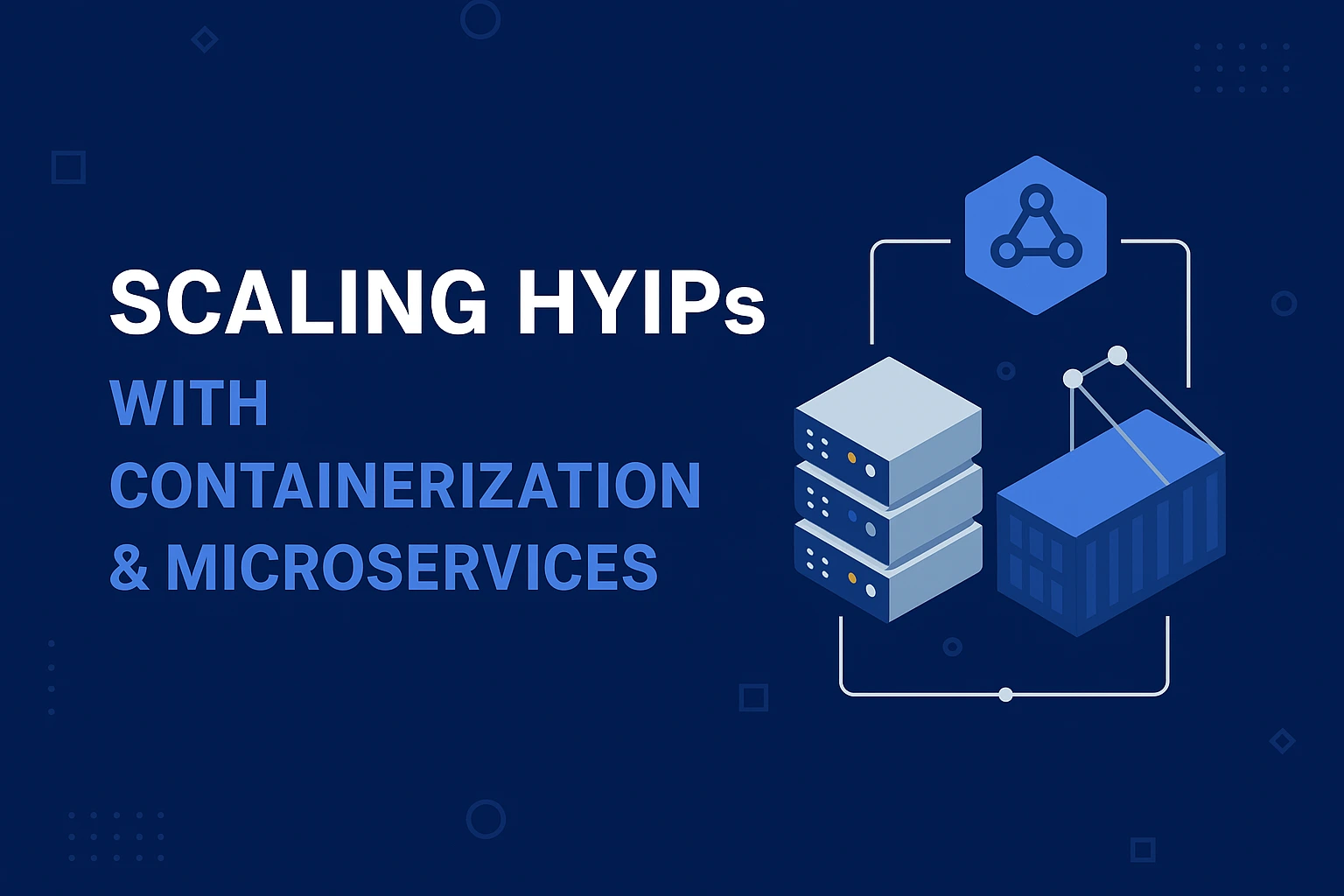High-Yield Investment Programs (HYIPs) are no longer just niche online ventures—they’re evolving into robust, high-traffic investment platforms that demand enterprise-grade scalability and performance. As these platforms grow, traditional monolithic architectures struggle to keep up. In this article, we’ll explore how containerization and microservices can solve common scaling problems, improve developer velocity, and bring enterprise resilience to your HYIP platform.
Why HYIPs Need to Scale Smarter
Most HYIP platforms start as simple web apps. But once your user base grows into the thousands—or your platform starts handling high-volume crypto payments and withdrawals—bottlenecks appear:
-
Slow page loads during traffic spikes
-
Delayed ROI calculations
-
Long payout queues
-
Security risks with growing codebase
-
Lack of system observability and traceability
To solve these issues, smart CTOs are moving to microservices powered by containers.
What Is Containerization?
Containerization is the practice of packaging software code with all its dependencies into lightweight units called containers. These containers are portable, scalable, and run consistently across development, staging, and production environments.
Popular container tools:
-
Docker
-
Podman
-
Containerd
Containers are ideal for HYIP apps because they allow each module—wallets, ROI engines, admin dashboard—to run independently and scale when needed.
What Are Microservices?
Microservices architecture breaks a large application into smaller, loosely coupled services. Each service handles a specific business function and communicates via APIs.
Example microservices in an HYIP platform:
-
🔐 Authentication Service
-
💰 Investment Plan Engine
-
🧾 Transaction Processing
-
📢 Notification Service
-
📊 Analytics and Reports
-
🪙 Crypto Payment Gateway
Each microservice can be developed, deployed, and scaled independently.
The Ideal HYIP Microservice Stack
A scalable HYIP platform might use a stack like:
| Layer | Technology Examples |
|---|---|
| Container Runtime | Docker, Kubernetes (K8s), Helm |
| API Gateway | NGINX, Kong, Istio |
| Service Communication | REST, gRPC, RabbitMQ, Kafka |
| Database Layer | PostgreSQL (for users), MongoDB (for logs), Redis |
| Security Layer | OAuth2, JWT, Hashicorp Vault |
| CI/CD Pipeline | GitHub Actions, GitLab CI, Jenkins |
| Monitoring/Logs | Prometheus, Grafana, ELK Stack |
How It Works in a HYIP Scenario
Let’s say your HYIP platform offers 4 investment plans with dynamic ROI payouts every 12 hours. A spike in traffic can crash your monolith. But in a microservices setup:
-
The Investment Plan Engine handles ROI calculations and payouts, and scales up only when needed.
-
The User Wallet Service deals with deposits/withdrawals, protected by strict access controls.
-
The Notification Microservice handles transactional emails, SMS, or WhatsApp updates asynchronously via queues.
-
The Analytics Service logs activity without affecting core services.
Everything works independently and efficiently—zero downtime, better throughput.
Benefits of Containerization & Microservices for HYIP
1. Scalability on Demand
-
Scale only the services under pressure (e.g., wallet or ROI engine)
-
Deploy multiple instances behind a load balancer
2. Faster Deployment Cycles
-
Update one service without redeploying the entire app
-
Use CI/CD pipelines to push production changes safely
3. Improved Security Posture
-
Isolate services to minimize the blast radius
-
Inject secrets securely via container orchestration tools
4. Better Fault Tolerance
-
A failure in the transaction microservice won’t crash the whole platform
-
Auto-restart failed containers using Kubernetes
5. Tech Stack Freedom
-
Use Node.js for wallet service, Python for analytics, Go for transaction processing—each in its own container
Real-World Use Case: Scaling with Kubernetes
One of GegoSoft’s clients—a crypto HYIP startup—scaled to 25,000 daily active users in under 6 months using a Kubernetes-powered HYIP platform.
They used:
-
Auto-scaling for traffic-heavy services
-
Secrets Manager for crypto API keys
-
Prometheus + Grafana for real-time metrics
-
Helm charts for one-click deployment of new services
The result? 99.99% uptime, 10x faster processing, and improved investor trust due to system reliability.
Migration Path: From Monolith to Microservices
Step-by-step migration plan for your HYIP platform:
-
Audit Your Current Architecture
Identify tightly coupled modules and bottlenecks. -
Containerize Your Monolith
Start by wrapping the whole app in Docker to gain environment consistency. -
Split Into Microservices
Extract core services—auth, ROI engine, wallet service—as standalone services. -
Use a Container Orchestrator
Deploy services on Kubernetes or Docker Swarm for auto-scaling and monitoring. -
Set Up Observability
Use Prometheus, ELK Stack, or Datadog to monitor traffic, ROI errors, and wallet health. -
Secure the Ecosystem
Use encrypted secrets, token auth, and API gateways for inter-service communication.
GegoSoft’s Role in Your Tech Evolution
At GegoSoft Technologies, we understand the infrastructure and compliance challenges that come with scaling investment platforms. That’s why our HYIP Script is built with a microservice-friendly architecture.
We help CTOs and DevOps leads:
-
Containerize their legacy investment platforms
-
Integrate with crypto wallets and payout APIs
-
Build secure, scalable investment microservices
-
Set up CI/CD and monitoring pipelines
Need DevOps or infrastructure consulting?
👉 Book a technical session with our team →
Conclusion: Build HYIPs That Can Handle Real Growth
Scaling your HYIP Platforms with Microservices is not just about handling traffic—it’s about building resilient, secure, and agile systems that can evolve with market demands.
Containerization + microservices offers a future-proof solution that gives your team control, your investors confidence, and your platform the reliability it needs to succeed.
🔗 Related Resources
-
Why CTOs Choose Our HYIP Script →
-
Crypto Wallet API Integration for HYIP Platforms →
-
DevOps Checklist for Fintech Applications →

